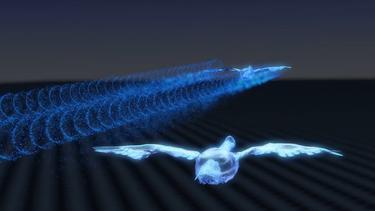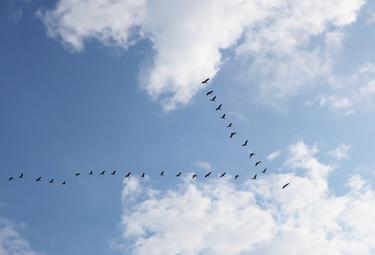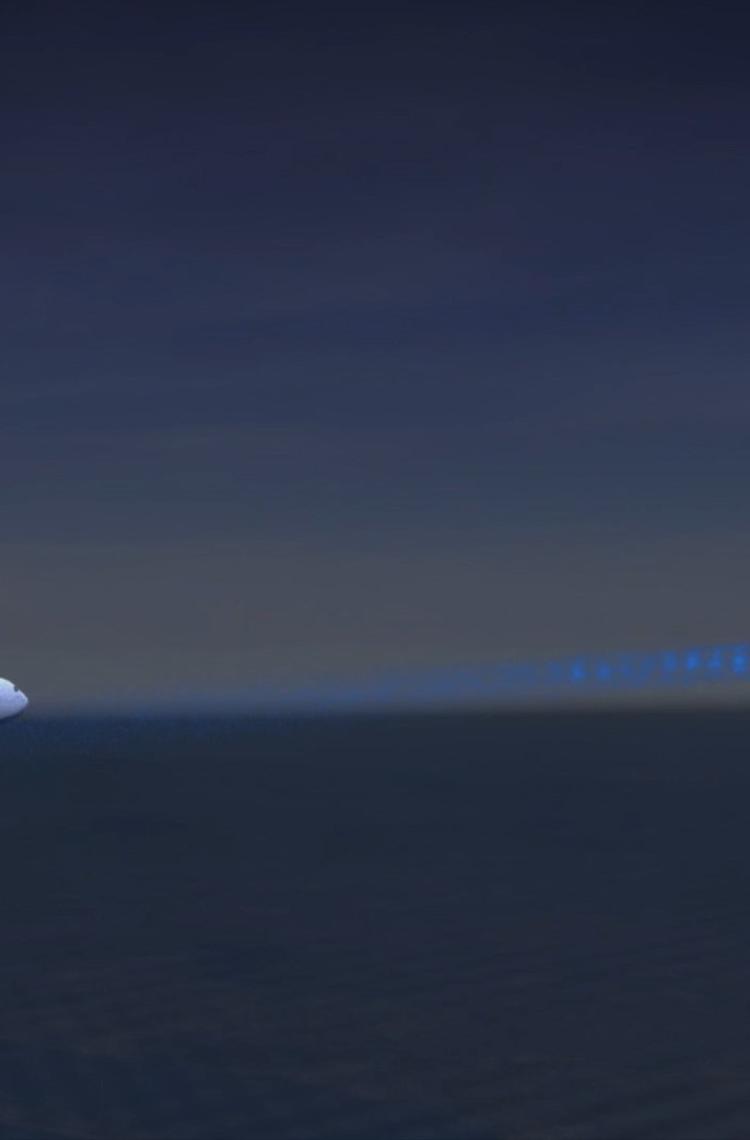Migrating geese fly in a “V” shape to save energy and benefit from the “air upwash” of the leader. For commercial aircraft, this flight technique—inspired by nature—represents a significant opportunity to help airlines to reduce fuel consumption and CO2 emissions.
It is a clear, cloudless day. Against the bright blue sky, a flock of geese is flying in a “V” shape in which a leader takes the pole position and the others spread out laterally behind it. For many, this is a familiar sight. But why do geese fly in this way?
To this question, some people might explain that this flight technique helps geese to save energy. And they would be right. However, scientists now understand that flying in a “V” shape is actually a lot more impressive than anyone had imagined.

When a bird flaps its wings, air flows over the wings and swirls upwards behind the wingtips. This flow creates a wake, which is a swirling movement of air containing kinetic energy. When the energetic core of the wake drags surrounding air, it creates smooth currents known as “upwash,” or air that moves upwards. When another bird enters the upwash, it immediately benefits from free lift, which enables it to stay aloft and expend a lot less energy.
The advantages of “wake energy retrieval”—the technical term for flying in upwash—have been written about for decades. However, given the aviation industry’s commitment to reduce aircraft emissions, Airbus is taking a fresh look at how this flight technique could provide aircraft with free lift, enabling them to reduce engine thrust and fuel consumption.
Wake energy retrieval: a new frontier for commercial aircraft
Just like birds, every aircraft creates a wake while flying. Flying together could thus help aircraft to retrieve the lost kinetic energy by positioning a follower aircraft in the air upwash of one of the lead aircraft’s wakes.
Several years ago, Airbus began investigating the benefits of wake energy retrieval for commercial aircraft. In 2016, a series of flight tests demonstrated that significant fuel savings could be achieved when two aircraft fly approximately 3 kilometres apart—without compromising passenger comfort.
To achieve this evolutionary step in operations, we have to look at the challenge from the perspective of all industry stakeholders. It’s a great opportunity for our industry to demonstrate a joint commitment to reducing our use of fossil fuels.
- Nick Macdonald, fello’fly Demonstrator Leader
At the time, air traffic management technology was not mature enough to enable aircraft to fly so close together in airspace. But significant technology improvements—including real-time flight tracking—are now being made. These technology improvements have paved the way for the development of fello’fly, a new flight demonstrator project within Airbus UpNext. The goal of fello’fly is to prove the technical, operational and economic viability of wake energy retrieval for commercial aircraft.
“Safety is our top priority at Airbus,” explains Nick Macdonald, fello’fly Demonstrator Leader. “We’re working to develop the functions necessary to assist pilots to safely stay in position behind the leader during a long-haul flight.”

A collaborative activity to achieve significant fuel savings
If the fuel-reduction technology behind fello’fly proves viable, the aviation industry will benefit from a collaborative activity that demonstrates a clear commitment—between manufacturers, airlines, air navigation service providers, regulators and authorities—to reduce fuel consumption and CO2 emissions.
And this collaborative activity could make a significant impact on aircraft’s environmental performance: fello’fly is expected to produce fuel savings of between 5-10% per trip. This means several tons of fuel and CO2 emissions could be saved during every fello’fly trip.
“To achieve this evolutionary step in operations, we have to look at the challenge from the perspective of all industry stakeholders,” Nick explains. “It’s a great opportunity for our industry to demonstrate a joint commitment to reducing our use of fossil fuels.”
